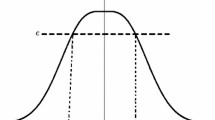Abstract
This paper deals with the problem of testing statistical hypotheses when both the hypotheses and data are fuzzy. To this end, we first introduce the concept of fuzzy p-value and then develop an approach for testing fuzzy hypotheses by comparing a fuzzy p-value and a fuzzy significance level. Numerical examples are provided to illustrate the approach for different cases.
Similar content being viewed by others
References
Arnold BF (1998) Testing fuzzy hypotheses with crisp data. Fuzzy Sets Syst 94: 323–333
Buckley JJ (2005) Fuzzy statistics: hypothesis testing. Soft Comput 9: 512–518
Casals MR, Gil MA, Gil P (1986) On the use of Zadeh’s probabilistic definition for testing statistical hypotheses from fuzzy information. Fuzzy Sets Syst 20: 175–190
Colubi A (2009) Statistical inference about the means of fuzzy random variables: applications to the analysis of fuzzy- and real-valued data. Fuzzy Sets Syst 160: 344–356
Couso I, Sanchez L (2008) Defuzzification of fuzzy p-values. In: Advances in soft computing, vol 48 (Soft methods for handling variability and imprecision). Springer, Heidelberg, pp 126–132
Denœux T, Masson MH, Hébert PA (2005) Nonparametric rank-based statistics and significance tests for fuzzy data. Fuzzy Sets Syst 153: 1–28
Dubois D, Prade H (1988) Possibility theory. Plenum Press, New-York
Filzmoser P, Viertl R (2004) Testing hypotheses with fuzzy data: the fuzzy p-value. Metrika 59: 21–29
Geyer CJ, Meeden GD (2005) Fuzzy and randomized confidence intervals and p-values. Stat Sci 20: 358–366
Grzegorzewski P (2000) Testing statistical hypotheses with vague data. Fuzzy Sets Syst 112: 501–510
Grzegorzewski P (2001) Fuzzy tests—defuzzification and randomization. Fuzzy Sets Syst 118: 437–446
Knight K (2000) Mathematical statistics. Chapman & Hall/CRC, Boca Raton
Lubiano MA, Gil MA (1999) Estimating the expected value of fuzzy random variables in random samplings from finite populations. Stat Pap 40: 277–295
Maple 9.5, Waterloo Maple Inc., Waterloo, Canada
Neyman J, Pearson ES (1933) The theory of statistical hypotheses in relation to probabilities a priori. Proc Camb Phil Soc 29: 492–510
Parchami A, Taheri SM, Mashinchi M (2010) Fuzzy p-value in testing fuzzy hypotheses with crisp data. Stat Pap 51: 209–226
Taheri SM, Arefi M (2009) Testing fuzzy hypotheses based on fuzzy test statistic. Soft Comput 13: 617–625
Taheri SM, Behboodian J (1999) Neyman–Pearson Lemma for fuzzy hypotheses testing. Metrika 49: 3–17
Taheri SM, Behboodian J (2001) A Bayesian approach to fuzzy hypotheses testing. Fuzzy Sets Syst 123: 39–48
Taheri SM (2003) Trends in fuzzy statistics. Austrian J Stat 32: 239–257
Tanaka H, Okuda T, Asai K et al (1979) Fuzzy information and decision in a statistical model. In: Gupta MM (eds) Advances in fuzzy set theory and applications.. North-Holland, Amsterdam, pp 303–320
Torabi H, Behboodian J, Taheri SM (2006) Neyman–Pearson lemma for fuzzy hypotheses testing with vague data. Metrika 64: 289–304
Torabi H, Behboodian J (2007) Likelihood ratio test for fuzzy hypotheses testing. Stat Pap 48: 509–522
Torabi H, Behboodian J (2005) Sequential probability ratio test for fuzzy hypotheses testing with vague data. Austrian J Stat 34: 25–38
Viertl R (1991) On Bayes’ theorem for fuzzy data. Stat Pap 32: 115–122
Viertl R (1996) Statistical methods for non-precise data. CRC Press, Boca Raton, Florida
Viertl R (2006) Univariate statistical analysis with fuzzy data. Comput Stat Data Anal 51: 133–147
Wang X, Kerre EE (2001) Reasonable properties for the ordering of fuzzy quantities (II). Fuzzy Sets Syst 118: 387–405
Watanabe N, Imaizumi T (1993) A fuzzy statistical test of fuzzy hypotheses. Fuzzy Sets Syst 53: 167–178
Yuan Y (1991) Criteria for evaluating fuzzy ranking methods. Fuzzy Sets Syst 43: 139–157
Zadeh LA (1965) Fuzzy sets. Inf Control 8: 338–359
Author information
Authors and Affiliations
Corresponding author
Rights and permissions
About this article
Cite this article
Parchami, A., Taheri, S.M. & Mashinchi, M. Testing fuzzy hypotheses based on vague observations: a p-value approach. Stat Papers 53, 469–484 (2012). https://doi.org/10.1007/s00362-010-0353-2
Received:
Accepted:
Published:
Issue Date:
DOI: https://doi.org/10.1007/s00362-010-0353-2




